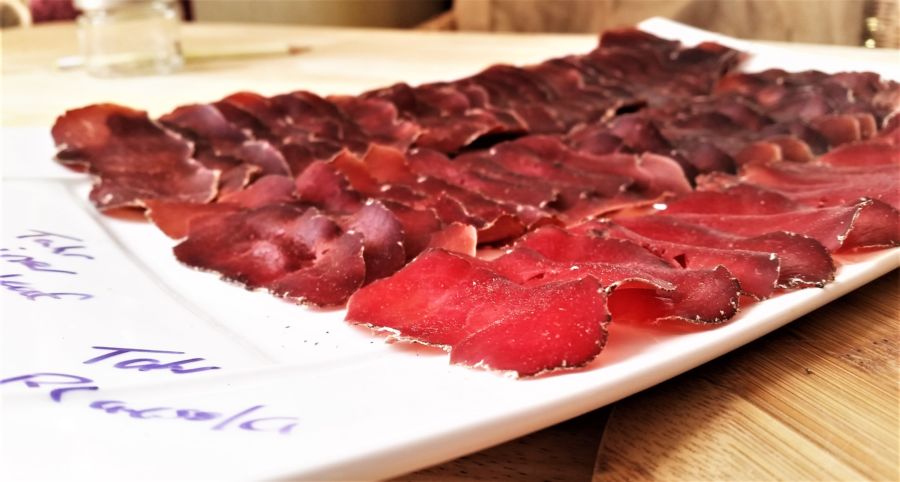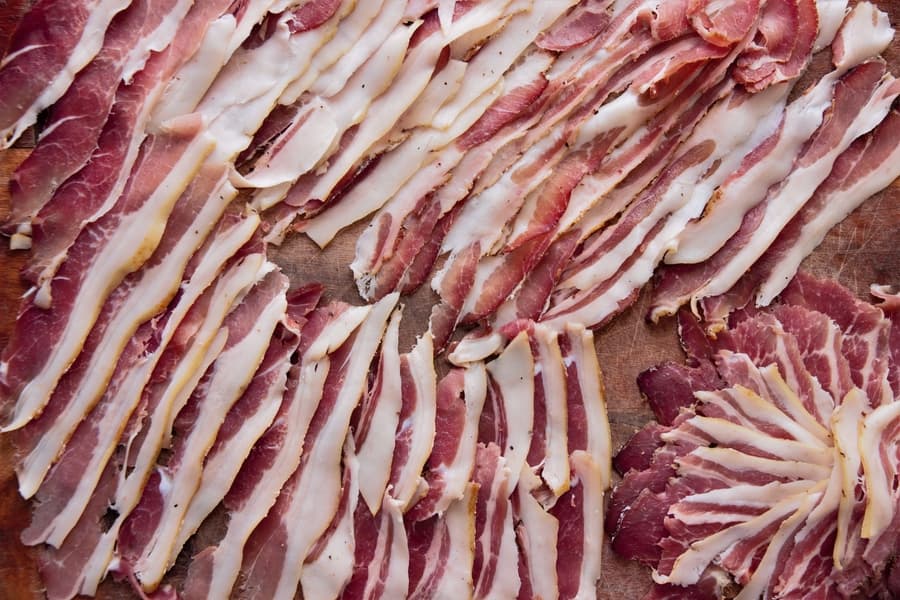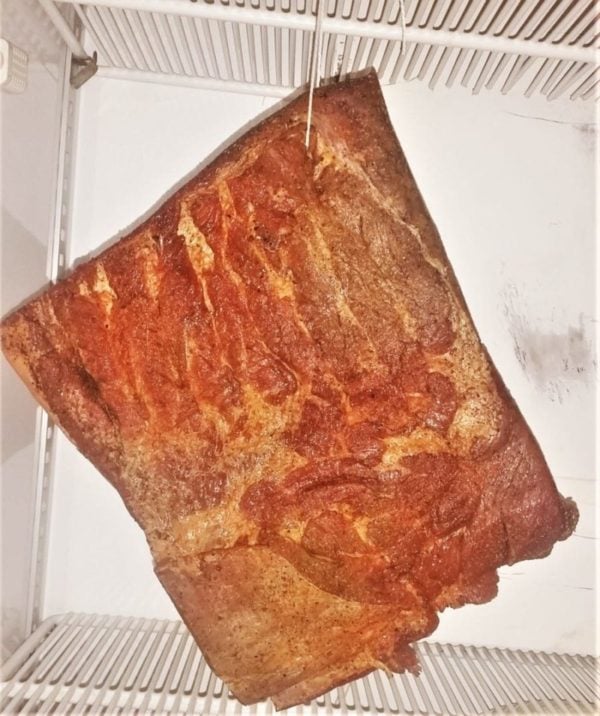One of my passions is dry curing meat it an old craft that can create amazing results, I get asked a lot about what is dry curing meat, many people think it has something to do with smoked meat. Sometimes, it does get smoked, but most of the time, it doesn’t, depending on the recipe and outcomes one desires.
Definition:
The meat is cured with a dry salt cure and then dried naturally. Using a dry salt cure removes moisture and intensifies the flavor. It also provides a preserving effect. Preserving occurs due to a drier environment that reduces the growth of bacteria that could spoil the meat.
Traditionally, dry-curing meat was used to preserve it for the long term. So when you harvested a pig, you would cut it up into major muscle groups and rub salt into it. Leaving it for a set amount of days.
There wasn’t any refrigeration or freezing back then. The salt removes the moisture, making the environment less friendly to bacteria that spoil the meat.
The pig was then enjoyed months later.

Some modern methods have been introduced, which now mean that if you’re dry curing to make Italian salumi or other types of cured meat, you can ensure that it doesn’t get too salty.
Salumi is all about dry curing the meat in a traditional Italian way, it include whole muscle and salami dry cured meats.
There are two main methods for dry curing. The modern method used when preserving/drying is called equilibrium curing.
The other method, which is still extensively used, is saturation or saltbox curing the meat (leaving the meat immersed for several days, depending on its weight).
What is Dry Cured Meat
All these dry cured meats are in essence ‘dried’ until they are safe
Popular Types of Dry-Cured Meat
Dry Cured Prosciutto
Prosciutto is fantastic; it’s a classic dry-cured pork leg ham that originated in Italy. No wet
The moisture is removed, which means bacteria can’t deteriorate the meat as easily, and salt helps the battle. Therefore, in a suitable environment (humidity and temperature controlled ideally), Prosciutto can be aged/dried for up to 4 years! That’s the premium stuff in Italy.
A type of Prosciutto from Parma, Parma Ham, which is quality pork and salt, is aged a minimum of 12 months. I think pigs are fed the leftover whey from the Parma cheese producers, making them the king of prosciutto.
Dry Cured Bacon

Some folks like to wet brine (salty water) bacon, and some like to dry-cure it. I prefer dry curing because removing the moisture intensifies the flavor. Adding spices or aromatics to dry-cured bacon enhances its flavor.
You can also make ‘green’ un-smoked bacon, but generally speaking, smoke gives bacon that bacon flavor we all love!
Making Bacon @ Home – If you want a comprehensive guide on wet brine, dry cure, or ‘green’ bacon, please find a post I wrote here.
Dry Cured Sausage

Basically, this is a name for dry-cured salami. I have met many Central or Eastern Europeans that use ‘sausage’ for what other Western world people call ‘salami’.
Dry curing sausage/salami involves fermenting, drying, and smoking the goods, generally speaking. There are thousands of variations across Europe, not just in Italy, the mighty dry curing capital of the World.
Methods to Dry Cure Meat
So, I have used two main methods for dry curing: the first one is a saturation method, where you rub salt all over the meat. The second method is measuring a percentage of salt in relation to the weight of the meat you are using to cure—equilibrium curing.
Salt Box Method (Classic Dry Curing)
The title of this method gives it away: you put salt in a box, and then you put the meat in the box. When using this method, you want to make sure every area of the meat has salt covered so that you get complete penetration into the meat.
Dry Curing for Preserving vs Quick Salt Curing for Moisture Retention
If you were curing, add some seasoning to the meat so you’re not looking to preserve a dry cure. Then, just a sprinkling of salt from both sides can enhance flavor. The above dry-cured turkey method is the way to go: 1/2 teaspoon fine salt to 1/2 kg/ 1 pound of meat.
<Back to Salt Box Method>
As you can imagine, it’s used for large pieces of meat. Many home curing enthusiasts use this method to make dry-cured bacon. Because you draw moisture out of the meat, it seems to intensify the flavor, including the aromatics and spices added to the cure.
Saltbox is based on leaving the meat in the cure for 1 day per 2 pounds/1 kg of meat
I would say pork belly would be a very popular salt box method (here is the how-to article on this) of dry curing because bacon is very popular (for a reason, it’s delicious!).
Equilibrium Curing

My favorite way of
What is Dry Curing Used For
So we have gone over Dry Cured Bacon, Ham, Sausage/Salumi & Quick Curing Turkey, what else?
The world of salumi with farmed or wild animals opens up many options.
Then there is jerky & biltong (salt & vinegar cured, technically wet brine).
I also use dry curing for trout, seafood,
I calculate the weight of the fish fillet and then 1.0%- 1.5% of that total weight. This is a method that I use instead of wet brining; it’s quicker and still does a
Wet brining is also used to hold moisture around the outer part of meat so it doesn’t dry out during low & slow cooking sessions.
After the curing process I will dry out overnight so that the pellicle forms. Once this is done the fish fillets are ready to be smoked.
If you haven’t tried smoking anything or want to know about various methods, check out my beginner’s guide here.
Check out some easy meat to smoke here, I just picked the simplest and wrote about them
Dry Curing Meat at Home
You can dry cure meat in a regular fridge. I generally like to use smaller, lean cuts of meat. You will end up drying the meat quicker because the humidity usually is around 30 to 50% in your fridge. For traditional Italian dry curing, you want humidity to be around 70%, but that is for long-term dry curing.
Then, when it comes to temperature, you want this to be around 11°C/52°F. Of course, a regular fridge operates much cooler than this. But as long as you’ve got a little bit of room to hang some dry cured meat, then it can be done in your fridge.
I also put together a DIY curing chamber. Being a passion, I knew I would be curing a lot of meat, so I bought a second-hand double-door massive drinks fridge. There is an online community of DIYers who have done this. Some exciting dry-cured meats have been showcased, which is very inspiring.
Using thermostat control, humidifier, dehumidifier, and an eco-panel heater. I am able to have complete control over humidity and temperature. The only other thing that’s needed is some airflow and some invisible ‘good’ bacteria’ – penicillin, to protect and help all the dry-cured meats.
What Meat is Dry Cured?
Technically, you can use any meat and dry cure it. I generally use game meat and
I like meat curing:
- Venison
- Beef
- Goat
- Pork
- Turkey
- Chicken
- Trout
- Salmon
- Various fish fillet
- Tahr
How Long Will the Dry Cured Meat Last
For dry-cured meats in the right environment with the above temperature and humidity, that can be 2 to 4 years. However, this is the maximum threshold. I have 4-5 year vacpacked cure meat in the fridge that are still fine.
When I do a dry cured meat project in my regular fridge, the last one to two weeks after being wrapped up. However, it tends to dry out quickly since the humidity is below the ideal 70% mark.
Dry cured meats from the fridge and jerky/biltong are what I take camping or other longer outdoor pursuit activities. If you want some ideas on meat for outdoor adventures, check out a post I wrote here.
Dry cured meat, like hot smoked meat, can last 7 to 10 days. They are not preserved.
Then, cold smoking can be dry cured first to help the drying out, which generally has months before spoiling.

Tom Mueller
For decades, immersed in studying, working, learning, and teaching the craft of meat curing, sharing the passion and showcasing the world of charcuterie and smoked meat. Read More
